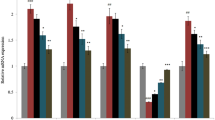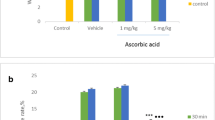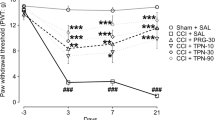Abstract
Purpose
p38 and Akt plays an important role in neuropathic pain. p38 appears to regulate the SVCT-2 expression, a specific transporter for ascorbic acid (an important antioxidant and neuromodulator). Vitamins C and E induce antinociception and appear to affect p38, Akt, and SVCT-2, but it is unknown their effect on these molecules in spinal cord of rats with chronic constriction injury (CCI) of the sciatic nerve, a model of neuropathic pain. So, we investigated the effect of vitamins C + E on the expression of p38, Akt, and transporter SVCT-2 and ascorbic acid content in the lumbosacral spinal cord of rats with CCI. TNF-α mRNA level was also determined.
Methods
Placement of four loose chromic thread ligatures around the sciatic nerve produced CCI. Ascorbic acid (vitamin C 30 mg/kg/day) + α-tocopherol (vitamin E 15 mg/kg/day) or vehicle (saline containing 1% Tween 80) were administrated (intraperitoneally) daily after CCI for 3 or 10 days. At the end of these periods, lumbosacral spinal cord was dissected out and used for assays.
Results
The vitamins prevented the increase in phosphorylated p38 and phosphorylated Akt and the decrease in SVCT-2 expressions, which were found in vehicle-treated CCI rats at days 3 and 10. Akt expression was reduced only at day 10. Vitamins also prevented the increase in ascorbic acid content and TNF-α level, which was found in vehicle-treated CCI rats.
Conclusions
The changes in p-p38, p-Akt, ascorbic acid, SVCT-2, and TNF-α may be contributing to antinociception induced by vitamins C + E in rats with CCI.







Similar content being viewed by others
Data availability
All data generated or analyzed in this study are included in this published article.
Abbreviations
- AA:
-
Ascorbic acid
- Akt:
-
Protein kinase B
- ANOVA:
-
Analysis of variance
- CCI:
-
Chronic constriction injury
- CEUA:
-
Ethics Committee of the Universidade Federal do Rio Grande do Sul
- DNPH:
-
2,4-Dinitrophenylhydrazine
- GAPDH:
-
Glyceraldehyde-3-phosphate dehydrogenase
- I.P. :
-
Intraperitoneal
- KCl:
-
Potassium chloride
- LPS:
-
Lipopolysaccharide
- MAPK:
-
Mitogen-activated protein kinases
- p-Akt:
-
Protein kinase B in phosphorylated form
- p-p38:
-
p38 in phosphorylated form
- SDS-PAGE:
-
Sodium dodecyl sulfate–polyacrylamide gel electrophoresis
- SVCT-2:
-
Sodium/vitamin C co-transporter isoform 2
- TNF-α:
-
Tumor necrosis factor-alpha
References
Kumar A, Harshpreet K, Singh A. Neuropathic pain models caused by damage to central or peripheral nervous system. Pharmacol Rep. 2018;70:206–16.
Colloca L, Ludman T, Bouhassira D, Baron R, Dickenson AH, Yarnitsky D, et al. Neuropathic pain. Nat Rev Dis Primers. 2017;3:17002.
Wawrzyniak A, Górnicka M, Hamułka J, Gajewska M, Drywień M, Pierzynowska G-SA. α-Tocopherol, ascorbic acid, and β-carotene protect against oxidative stress but reveal no direct influence on p53 expression in rats subjected to stress. Nutr Res. 2013;33:868–75.
Salazar K, Martinez F, Pérez-Martin M, Cifuentes M, Triqueros L, Ferrada L, et al. SVCT2 expression and function in reactive astrocytes is a common event in different brain pathologies. Mol Neurobiol. 2017;23:23.
Okubo M, Yamanaka H, Kobayashi K, Kanda H, Dai Y, Noguchi K. Upregulation of platelet-activating factor synthases and its receptor in spinal cord contribute to development of neuropathic pain following peripheral nerve injury. Mol Pain. 2012;8:8.
Schencking M, Sandholzer H, Frese T. Intravenous administration of vitamin C in the treatment of herpetic neuralgia: two case reports. Med Sci Monit. 2010;16:58–61.
Bruno RS, Leonard SW, Atkinson J, Montine TJ, Ramakrishnan R, Bray TM. Faster plasma vitamin E disappearance in smokers is normalized by vitamin C supplementation. Free Radic Biol Med. 2006;40:689–97.
Meymandi MS, Sepehri G, Izadi G, Zamiri Z. Evidence for antinociceptive effects of combined administration of vitamin E and celecoxib in tail-flick and formalin test in male rats. Pharmacol Rep. 2019;71:457–64.
Naziroglu M, Özgül C. Vitamin E modulates oxidative stress and protein kinase C activator (PMA)-induced TRPM2 channel gate in dorsal root ganglion of rats. J Bioenerg Biomembr. 2013;45:541–9.
Garelnabi N, Veledar E, White-Welkley J, Santanam N, Abramson J, Weintraub W, et al. Vitamin E differentially affects short term exercise induced changes in oxidative stress, lipids, and inflammatory markers. Nut Metab Cardiovasc Dis. 2012;22:907–13.
Wu D, Hayek MG, Meydani S. Vitamin E and macrophage cyclooxygenase regulation in the aged. J Nutr. 2001;131:382S–8S.
Riffel APK, de Souza JA, do CQ SM, Horst A, Scheid T, Kolberg C, et al. Systemic administration of vitamins C and E attenuates nociception induced by chronic constriction injury of the sciatic nerve in rats. Brain Res Bull. 2016;121:169–77.
Jaggi AS, Jain V, Singh N. Animal models of neuropathic pain. Fundam Clin Pharmacol. 2011;25:1–28.
Huang YN, Lai CC, Chiu CT, Lin JJ, Wang JY. L-ascorbate attenuates the endotoxin-induced production of inflammatory mediators by inhibiting MAPK activation and NF- κB translocation in cortical neurons/glia cocultures. PLoS One. 2014;9:1–12.
Giraldo E, Lloret A, Fuchsberger T, Viña J. Aβ and tau toxicities in Alzheimer’s are linked via oxidative stress-induced p38 activation: protective role of vitamin E. Redox Biol. 2014;2:873–7.
Zakharova IO, Sokolova TV, Vlasova YA, Bayunova LV, Rychkova MP, Avrova NF. α-tocopherol at nanomolar concentration protects cortical neurons against oxidative stress. Int J Mol Sci. 2017;18:216.
Moretti M, Budni J, Ribeiro CM, Rieger DK, Leal RB, Rodriques ALS. Subchronic administration of ascorbic acid elicits antidepressant-like effect and modulates cell survival signaling pathways in mice. J Nutr Biochem. 2016;38:50–6.
Guo J, Wang H, Jin X, Jia D, Zhou X, Tao Q. Effect and mechanism of inhibition of PI3K / Akt / mTOR signal pathway on chronic neuropathic pain and spinal microglia in a rat model of chronic constriction injury. Oncotarget. 2017;8:52923–34.
Jiang L, Pan CL, Wang CL, Liu BQ, Han Y, Hu L, et al. Selective suppression of the JNK-MMP2/9 signal pathway by tetramethylpyrazine attenuates neuropathic pain in rats. J Neuroinflamm. 2017;14:174.
Tian H, Ye X, Hou X, Yang X, Yang J, Wu C. SVCT2, a potential therapeutic target, protects against oxidative stress during ethanol-induced neurotoxicity via JNK/p38 MAPKs, NF-κB and miRNA 125a-5p. Free Radic Biol Med. 2016;96:362–73.
Covarrubias-Pinto A, Acuña AI, Beltrán FA, Torres-Díaz L, Castro MA. Old things new view: ascorbic acid protects the brain in neurodegenerative disorders. Int J of Mol Sci. 2015;16:28194–217.
Horst A, Souza JA, Santos MCQ, Riffel APK, Kolberg C, Partata WA. Effects of N-acetylcysteine on spinal cord oxidative stress biomarkers in rats with neuropathic pain. Braz J Med Biol Res. 2017;50:12.
Bennett GJ, Xie YK. A peripheral mononeuropathy in rat that produces disorders of pain sensation like those seen in man. Pain. 1988;33:87–107.
Roe JH, Kuether CA. The determination of ascorbic acid in whole blood and urine through the 2,4-dinitrophenylhydrazine derivative of dehydroascorbic acid. J Biol Chem. 1943;147:399–407.
Ding Y, Yao P, Hong T, Li H, Zhu Y, Han Z, et al. The analgesic effect of early hyperbaric oxygen treatment in chronic constriction injury rats and its influence on nNOS and iNOS expression and inflammatory factor production. Mol Pain. 2018;14:1–11.
Chomczynski P, Sacchi N. Single-step method of RNA isolation by acid guanidium thiocyanate-phenol-chloroform extraction. Anal Biochem. 1987;162:156–9.
Lu R, Kallenborn-Gerhardt W, Geisslinger G, Schmidtko A. Additive antinociceptive effects of a combination of vitamin C and vitamin E after peripheral nerve injury. PLoS One. 2011;6:1–9.
Hu JY, Li CH, Wang YW. Intrathecal administration of triptolide, a T lymphocyte inhibitor, attenuates chronic constriction injury-induced neuropathic pain in rats. Brain Res. 2012;1436:122–9.
Piao JM, Zhong-Xi WW, Yu-Zhen Y, Luo LQ, Yu J. MicroRNA-381 favors repair of nerve injury through regulation of the SDF-1/ CXCR4 signaling pathway via LRRC4 in acute cerebral ischemia after cerebral lymphatic blockage. Cell Physiol Biochem. 2018;46:890–906.
Tsuda M, Masuda T, Tozaki-Saitoh H, Inoue K. Microglial regulation of neuropathic pain. J Pharm Sci. 2013;121:89–94.
Watkins LR, Milligan ED, Maier SF. Glial activation: a driving force for pathological pain. Trends Neurosci. 2001;24:450–1.
Sumizono M, Sakakima H, Otsuka S, Terashi T, Nakanishi K, Ueda K, et al. The effect of exercise frequency on neuropathic pain and pain-related cellular reactions in the spinal cord and midbrain in a rat sciatic nerve injury model. J Pain Res. 2018;11:281–91.
Mika J, Osikowicz M, Rojewska E, Korostynski M, Wawrzczak-Bargiela A, Przewlocki R, et al. Differential activation of spinal microglial and astroglial cells in a mouse model of peripheral neuropathic pain. Neuropharmacol Analgesia. 2009;623:65–72.
Portugal CC, Socodato R, Canedo T, Silva CM, Martins T, Coreixas VSM, et al. Caveolin-1–mediated internalization of the vitamin C transporter SVCT2 in microglia triggers an inflammatory phenotype. Sci Signal. 2017;10:2005.
VanHook A. Vitamin C prevents microglia activation. Science. 2017;355:1386–8.
Egger T, Schuligoi R, Wintersperger A, Amann R, Malle E, Sattler W. Vitamin E (α-tocopherol) attenuates cyclo-oxygenase 2 transcription and synthesis in immortalized murine BV-2 microglia. Biochem J. 2003;370:459–67.
Lee G, Grovey B, Furnish T, Wallace M. Medical Cannabis for neuropathic pain. Cur Pain Headache Rep. 2018;22:1–8.
Li R, Shen L, Yu X, Ma C, Huang Y. Vitamin C enhances the analgesic effect of gabapentin on rats with neuropathic pain. Life Sci. 2016;15:25–31.
Li Z, Wei H, Piirainen S, Chen Z, Kalso E, Pertovaara A, et al. Spinal versus brain microglial and macrophage activation traits determine the differential neuroinflammatory responses and analgesic effect of minocycline in chronic neuropathic pain. Brain Behav Immun. 2016;58:107–17.
Acuña A, Esparza M, Kramm C, Beltra FA, Parra AV, Cepeda C, et al. A failure in energy metabolismo and antioxidante uptake precede symptoms of Huntington’s disease in mice. Nat Commun. 2013;4:2917.
Liu W, Lv Y, Ren F. PI3K/Akt pathway is required for spinal central sensitization in neuropathic pain. Cell Mol Neurobiol. 2018;38:747–55.
Meacham K, Shepherd A, Mohapatra DP, Haroutounian S. Neuropathic pain: central vs. peripheral mechanisms. Curr Pain Headache Rep. 2017;21:1–6.
Park JM, Kim CK, Lee HC, Jung H, Choi KU, Hong SW, et al. Antiallodynic effects of vitamin C and vitamin E in chronic post-ischemia pain rat model. Korean J. 2013;65(5):442–8.
Grace PM, Gaudet AD, Staikopoulos V, Maier SF, Hutchinson MR, Salvemini D, et al. Nitroxidative signaling mechanisms in pathological pain. Trends Neurosci. 2016;39:862–79.
Riffel APK, Santos MCQ, Souza JA, Scheid T, Horst A, Kolberg C, et al. Treatment with ascorbic acid and α-tocopherol modulates oxidative-stress markers in the spinal cord of rats with neuropathic pain. Braz J Med Biol Res. 2018;51:1–11.
Ferreira NR, Ledo A, Laranjinha J, Gerhardt GA, Barbosa RM. Simultaneous measurements of ascorbate and glutamate in vivo in the rat brain using carbono fiber nanocomposite sensors and microbiosensor arrays. Bioelectrochemistry. 2018;121:142–50.
Desrumaux CM, Mansuy M, Lemaires S, Przybilski J, Le Guern N, Givalois L, et al. Brain vitamin D deficiency during development is associated with increased glutamate levels and anxiety in adult mice. Front Behav Neurosci. 2018;12:310.
Scheid T, Bosco LD, Guedes RP, Pavanato MA, Belló-Klein A, Partata WA. Sciatic nerve transection modulates oxidative parameters in spinal and supraspinal regions. Neurochem Res. 2013;38:935–42.
Goecks CS, Horst A, Moraes MS, Scheid T, Kolberg C, Belló-Klein A, et al. Assessment of oxidative parameters in rat spinal cord after constriction of the sciatic nerve. Neurochem Res. 2012;37(9):1952–8.
Funding
This work was supported by grants from Fundação de Amparo à Pesquisa do Estado do Rio Grande do Sul (FAPERGS—process 2010/1007354) and Conselho Nacional de Desenvolvimento Científico e Tecnológico (CNPq—process 870582/1997-5).
Author information
Authors and Affiliations
Contributions
A.P.K.R and W.A.P. were responsible for the study concept and design and they prepared and wrote the manuscript. A.P.K.R., J.A.S., M.C.Q.S., A.K., E.M.S.S., T.S., A.H., C.K., and G.M. performed the experiments. L.S.F and M.F.M.R. helped in the Western blotting procedure and analysis. All authors approved the final manuscript.
Corresponding author
Ethics declarations
Conflict of interest
The authors declare that they have no conflict of interest.
Ethics approval
This study was approved by the Ethics Committee of the Universidade Federal do Rio Grande do Sul (CEUA-UFRGS #23352).
Rights and permissions
About this article
Cite this article
Riffel, A.P.K., de Souza, J.A., Santos, M. et al. Co-administration of ascorbic acid and α-tocopherol modifies ascorbic acid and attenuates p38, Akt, and TNF-α expression in spinal cord of rats with neuropathic pain. Nutrire 45, 9 (2020). https://doi.org/10.1186/s41110-019-0113-6
Received:
Accepted:
Published:
DOI: https://doi.org/10.1186/s41110-019-0113-6




